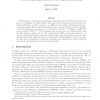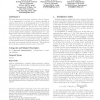1081 search results - page 8 / 217 » Working with the LR Degrees |
STOC
2005
ACM
14 years 10 months ago
2005
ACM
We investigate constructions of pseudorandom generators that fool polynomial tests of degree d in m variables over finite fields F. Our main construction gives a generator with se...
STOC
2005
ACM
14 years 10 months ago
2005
ACM
Understanding the graph structure of the Internet is a crucial step for building accurate network models and designing efficient algorithms for Internet applications. Yet, obtaini...
COMPGEOM
2010
ACM
14 years 2 months ago
2010
ACM
We study the expected number of interior vertices of degree i in a triangulation of a point set S, drawn uniformly at random from the set of all triangulations of S, and derive va...
JSYML
2010
13 years 4 months ago
2010
We say a countable model A has a 0-basis if the types realized in A are uniformly computable. We say A has a (d-)decidable copy if there exists a model B = A such that the element...
CIE
2005
Springer
14 years 3 months ago
2005
Springer
The strong weak truth table reducibility was suggested by Downey, Hirschfeldt, and LaForte as a measure of relative randomness, alternative to the Solovay reducibility. It also occ...


